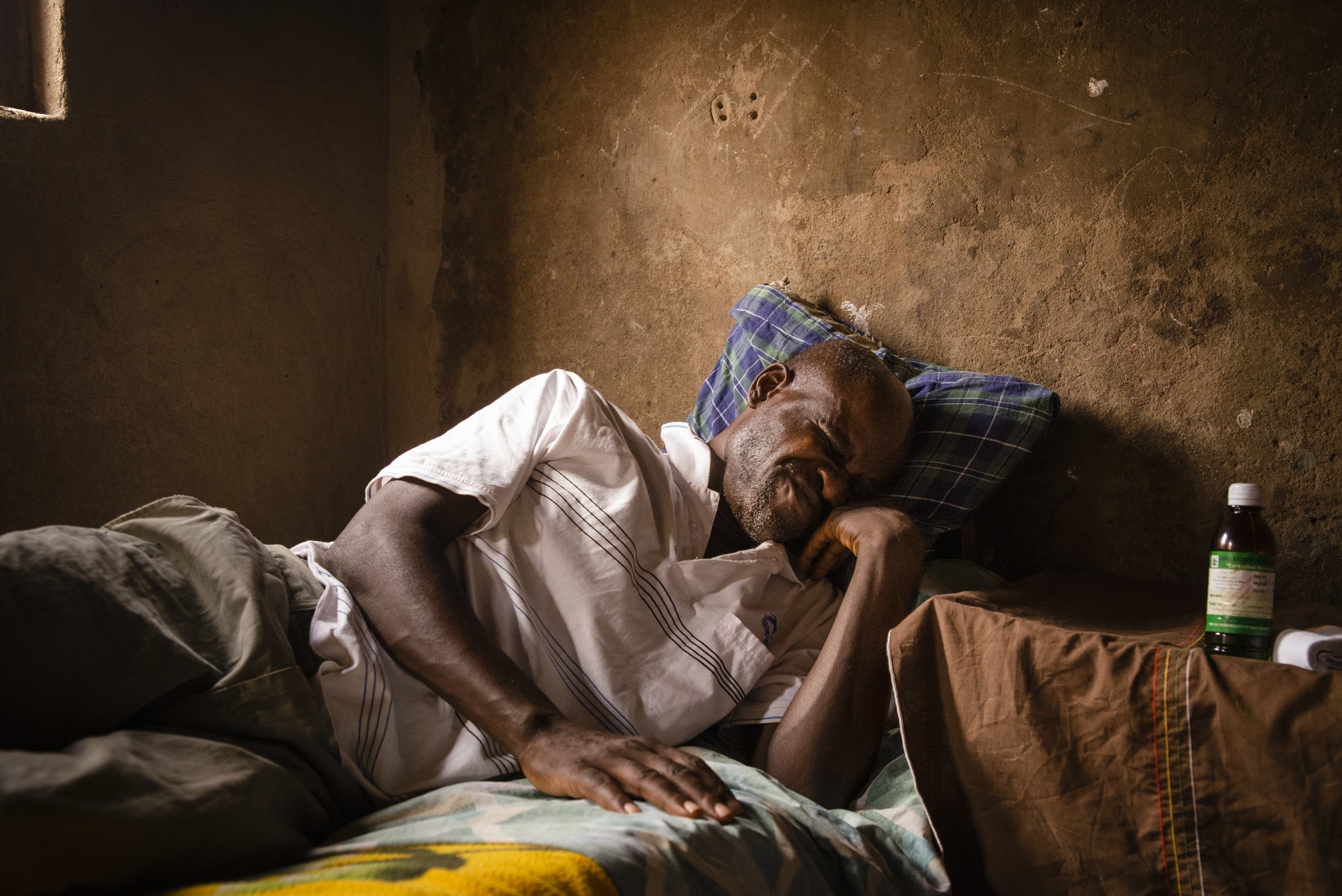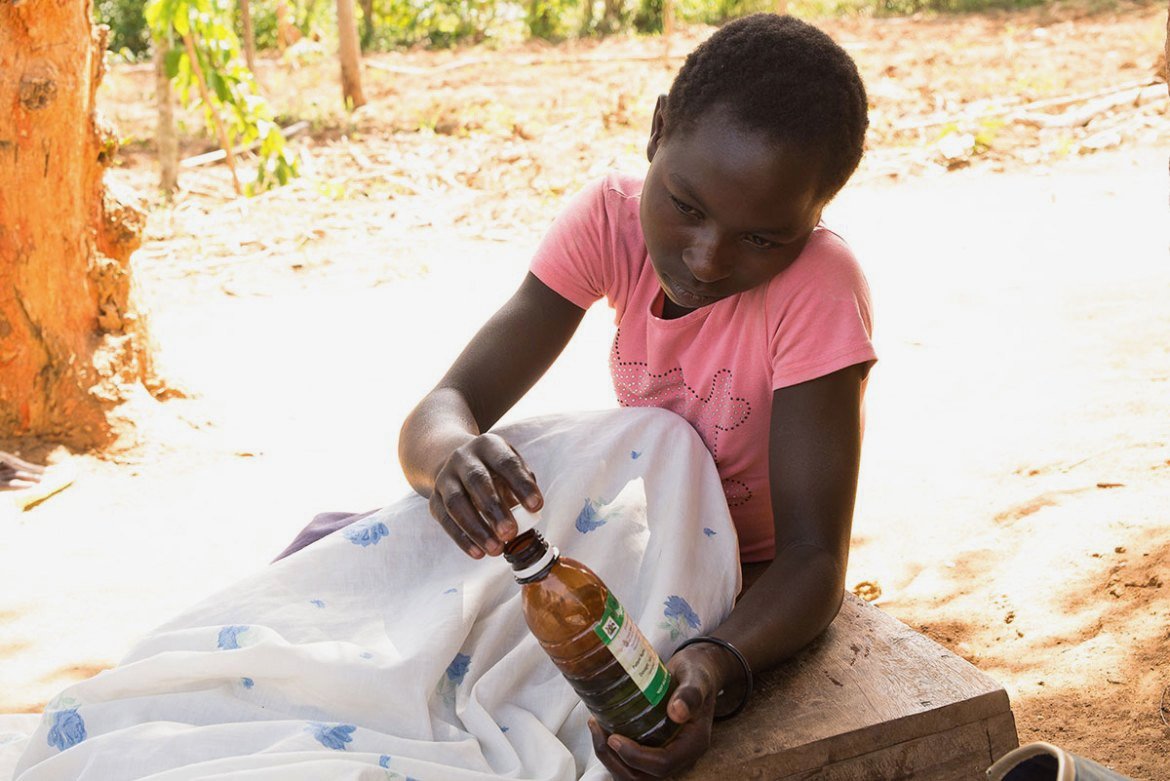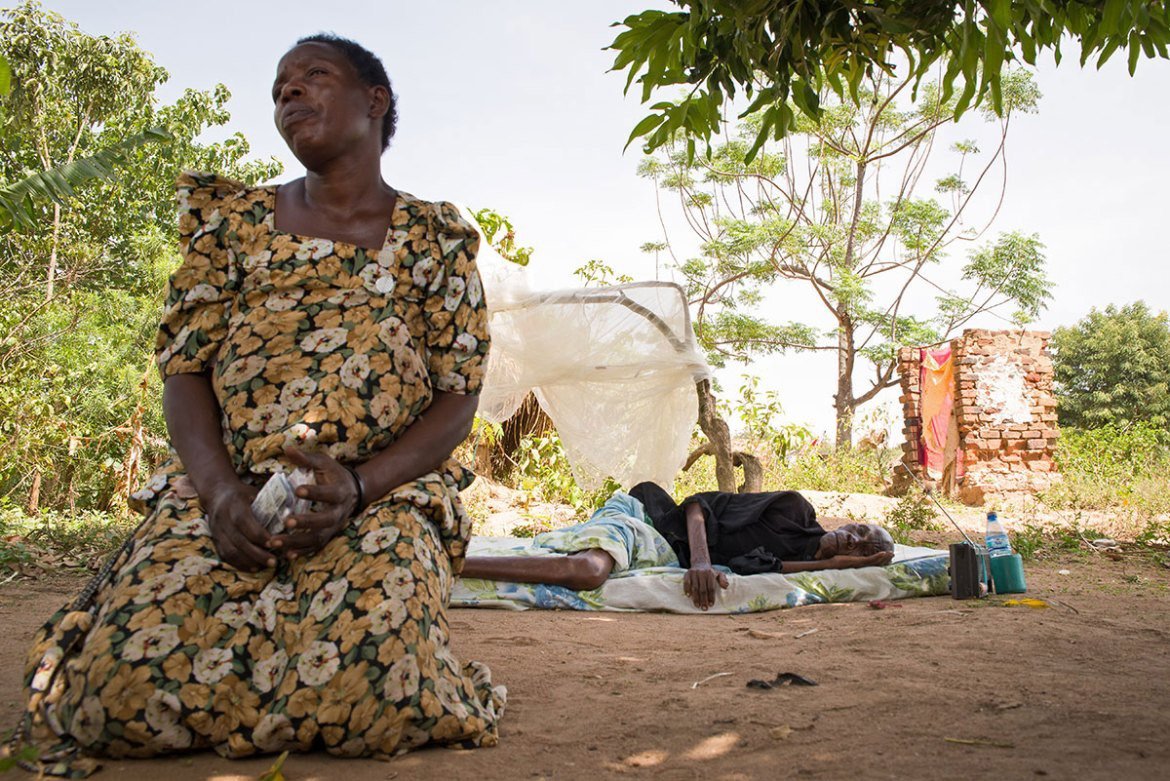Waiting to die: Uganda’s untreated cancer patients
Since its only external beam radiotherapy machine broke in April, Ugandans having been dying of treatable cancers.
Al Jazeera English
Harriet Namuwoya and her mother pose for a photo inside their home in the Busoga region of southern Uganda. The 32-year-old mother had abdominal cancer diagnosed last year. Nurses believe her watermelon-sized abdominal tumour would have responded favourably to radiation therapy had the country's 21-year-old external-beam radiotherapy machine remained operational. But it broke last April and has not been replaced. Photo: Katie G. Nelson
Jinja, Uganda – With his shoulders hunched forward and his hands curled over the curve of the steering wheel, James Isabirye scans a dusty road in southern Uganda for signs of life. The driver at Rays of Hope Hospice Jinja is looking for a narrow inlet, somewhere between a neighbourhood shop and a primary school, that his colleague and passenger Esther Apolot is directing him to.
“And you remembered to pack the morphine?” Esther asks. “This patient is very sick.”
James takes a hard left turn down a winding footpath carved in the dirt, which grows increasingly narrow until it dead-ends at two crumbling redbrick houses.
“This is it,” says Esther. “She’s inside.”
Covered by a single sheet atop a foam mattress on the concrete floor is 32-year-old Harriet Namuwoya. The mother of seven has abdominal cancer. A watermelon-sized tumour protrudes from her stomach.
“She’s in a lot of pain,” says Esther. “If it was caught earlier, she would’ve benefited from radiation.”
Harriet is not alone.
She is one of hundreds of patients dying from treatable cancer in Uganda after the country’s only external-beam radiotherapy machine broke last April. It has not been replaced.
Too poor to travel to the nearest machine in Nairobi, Kenya, where treatment and living expenses for the duration of treatment often run upwards of $5,000, Harriet and those like her are simply waiting to die in homes across Uganda.
Hospice nurses talk to Harriet Namuwoya inside her home. Namuyowa is unable to walk do to nerve pain caused by the large, cancerous tumour in her stomach. The former farmer and mother-of-seven now spends her days sleeping on a sunken foam mattress inside her dimly lit bedroom.
Nurses from Hospice Jinja visit up to 20 patients a day, providing free pain management and end-of-life care to low-income patients, many of whom are dying from treatable forms of cancer because they cannot afford treatment in neighbouring Kenya. 'Our job is controlling pain and making sure the wound is clean,' explains nurse Esther Apolot. 'That's all we can do.'
Nurses with Hospice Jinja hand Grace Auma her monthly allowance of pain medication. She has advanced-stage cervical cancer and began receiving care from Hospice Jinja in October 2016, seven months after Uganda's only radiotherapy machine broke down.
'Does the government know there are people suffering like this?' asks Esther Apolot.
'The answer is 'yes'.
Kasita Nabiuye, 50, receives two bottles of morphine to control the pain from her advanced-stage breast cancer.
Public hospitals in Uganda rarely stock liquid morphine or other pain medication, explains Dr Paul Kibirige, a physician at Bumanya Health Centre. Kibirige says his clinic, which serves 20,000 patients, 'can't do much' for those dying from cancer.
'Really, they need to go to Nairobi for treatment, but in this region no one can do that, so they die in pain,' he says.
Forty-five-year-old farmer Musa Gali was diagnosed with ocular melanoma last year but received only one round of treatment at Mulago Hospital in Kampala before the machine broke down.
'Because of that machine not being there, he is going to die in a terrible state,' says Hospice Jinja's operations manager Sylvia Nakami.
Monica Nakayima cries inside her home in Jinja, Uganda.
The 45-year-old mother complained of weakness caused by heavy pelvic bleeding, likely a symptom of ovarian cancer. Unable to afford treatment in neighbouring Kenya, Nakayima stays alone inside her thatched-roof hut.
'She is not well,' says Esther Apolot. 'I am very worried about her.'
Hospice Jinja is one of the only nonprofit organisations in the region that focuses on 'death and dying with dignity', explains operations manager Sylvia Nakami.
Hospice Jinja provides free medical care, pain medication and face-to-face counselling to more than 400 patients.
Florence Nabeeta's daughter sprinkles antibiotic medication on her mother's tumour, located above her left breast.
Chris Waako, 50, winces in pain after running out of liquid morphine earlier that week.
Waako, who had colon cancer diagnosed last year, was unable to afford a $210 colonoscopy and a $111 CT Scan, which doctors said were necessary before he could receive cancer radiation treatment. Now Waako depends on medication provided by Hospice Jinja to cope with the pain associated with the disease.
Sualina Namikose, 14, reads instructions for her mother's pain medication outside their home. The youngest of nine children, Sualina is the sole caretaker for her mother, who is dying from breast cancer.
'No one does it but her,' explains Esther Apolot.
Madina Namikose, 41, receives a dose of liquid morphine from her 14-year-old daughter and primary caretaker Sualina Namikose.
Nurses with Hospice Jinja believe Madina and 'many, many others' would be benefiting from radiation therapy had the machine remained operational.
'Now, the future is bleak,' says the hospice's operations manager Sylvia Nakami.
'There are many many patients, especially the poor ones, who just give up and say 'Don't let me suffer. Let me wait for my death … let me die.''
Nuhu Malinga's wife speaks to hospice nurses while her husband rests on a mattress behind her. Too hot to stay indoors, the 68-year-old with kidney cancer spends most of his time sleeping on a thin foam mattress outside their thatched-roof home.
Unable to eat and covered in bed sores, Beatrice Akoth, 23, cries inside her father's home in Mbaale, Uganda.
Akoth was diagnosed with liver cancer last March but was unable to receive radiation treatment at Mulago Hospital in Kampala.
Uganda's Ministry of Health agreed to transport 400 cancer patients to Kenya to undergo cancer radiation treatment after Uganda's only radiotherapy machine broke last April. It is unclear how many patients actually benefited from this programme.
Beatrice Akoth's father waits outside her bedroom. The installation of Uganda's new radiotherapy machine is still months away, according to the Ugandan Ministry of Health, far too late for Akoth. Nurses believe she has less than three months to live.
Joyce Matama, 80, thanks hospice nurses for bringing medication to relieve the pain caused by cervical cancer.
'Today, the pain is controlled,' the nurses reported.
Joyce is one of 414 patients benefiting from Hospice Jinja's pain management and end-of-life care.
'Still, I think there are many, many more who need our help,' explains the hospice's operations manager Sylvia Nakami.















